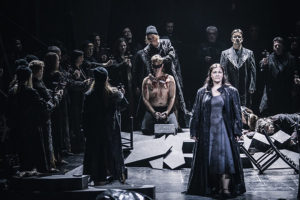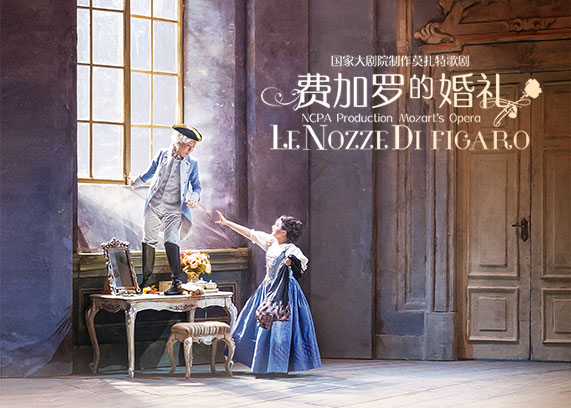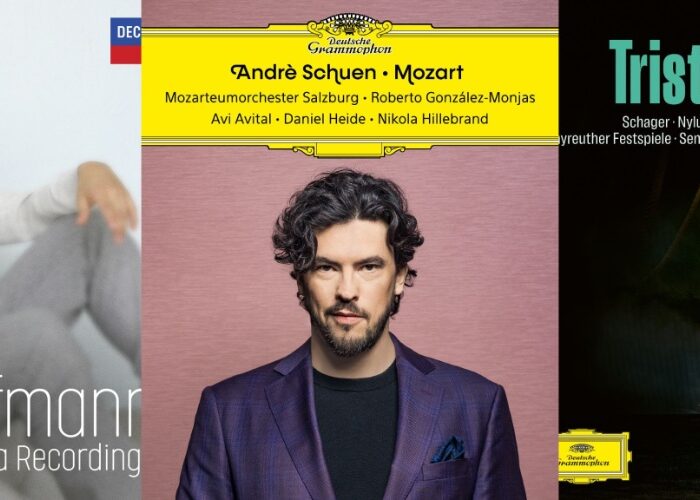
Slovenian National Opera 2019-20 Review: The Maid Of Orleans
A Rarely Performed Tchaikovsky Masterpiece Receives A Strong Production Crowned By Nuska Drascek Rojko As Joan Of Arc
By Alan Neilson(Credit: SNG Opera/Darja Stravs Tisu)
Performances of Tchaikovsky’s “The Maid of Orleans” are fairly rare, yet when it was premiered in 1881 it was considered to have been an unqualified success, and became the first of his operas to be staged outside Russia, in Prague the following year. It also proved to be his most ambitious opera, in which he used the model of French grand opera as the basis for its structural design, and thus set himself up to be compared with Verdi, Meyerbeer and others who had enjoyed success in the genre. However, the opera’s success proved to be short-lived, and was withdrawn from the stage two weeks after its premiere for political reasons. Since which time it has remained little more than a curiosity, even recordings are few in number. The Slovenian National Opera’s new production, therefore, provided a welcome opportunity to experience one of Tchaikovsky lesser known stage works.
The opera, in four acts, traces the tumultuous deeds of the French heroine Joan of Arc, although unsurprisingly it is a loose rendering of the actual historical events, incorporating additional material such as a love interest between Joan and an enemy soldier, and a vindictive father who betrays her. Typical for a grand opera the work makes use of numerous large choruses, a significant number of soloists, a dance scene and it moves between personal intimate settings to wider large scale scenes, such as Charles VII’s coronation.
A Clear Vision
Frank Van Laecke, the Director for this production, had a clearly defined vision for the work, one which streamlined the narrative and defined the aesthetic of the staging. Instead of moving in tandem with the works changing emotional states, he decided to focus almost entirely upon the dark and gloomy aspects of the work, namely the effects of the war, Joan’s visions for which she would be burnt at the stake and the anxiety which lay at the heart of the French state in the figure of the inadequate Charles VII. Anything which might lighten the work was cut, such as the Act two ballet, or downplayed as in the case of the opening chorus, in which the maidens who were supposed to be celebrating a village festival were grouped, huddled in a war damaged church, the atmosphere heavy with anxiety and fear.
Philippe Miesch, responsible for the stage designs, accentuated the darkness and brutality of war by setting the majority of the work among a rubble strewn, half-collapsed building which sometimes was a church, sometimes a castle, or sometimes just the debris of war. The lighting, also designed by Van Laecke, rarely did anything to lift the darkness. Likewise, Belinda Radulovic’s costume designs, with the exception of the King and Queen, were modern and very dark, usually black.
Each scene was cleverly mastered in itself, but the accumulative effect was of an insistent heaviness, which towards the middle of Act four was starting to become a little one-paced. However, Van Laecke brilliantly rescued the situation with a final scene which shattered any suggestion that the narrative’s dramatic drive had been lost. The timber strewn stage was cleared and used to construct a bonfire for Joan’s execution. As the angelic voices sing their forgiveness, Joan is doused in petrol, and the executioners prepare to set the bonfire alight as the curtain falls. The tension of the scene was built with a sure hand, its release coming only as the curtain had fallen, perfectly synchronized to the music.
Nevertheless, the production did raise a notable concern. For sure, Van Laecke’s presentation was successful in itself, however, when looking at the wider context it is evident that such an approach to directing tragedies, especially Romantic tragedies, is almost becoming de rigueur. Time and time again it is normal to see black scenery, black modern day costumes, darkness, a gloomy atmosphere, mist lying across the stage highlighted by subdued lighting. Certainly, the approach works, but it is becoming a little too commonplace to capture the imagination. Maybe it is time for directors to become a little more adventurous.
Obviously, the opera centers on the character of Joan, her military prowess and her eventual execution for witchcraft. Van Laecke’s development of Joan, was expertly drawn, frequently setting her aside from the rest of the cast to highlight her difference, which not only allowed for her adulation, but also opened her up to charges of witchcraft. Often she would be seen sitting alone striking matches, a nicely placed metaphor which was carried through the drama; she is playing with fire, as anyone who claimed to have received visions in medieval Europe was likely to find out, and of course her own behavior strikes the match which ultimately leads to her being burned at the stake. Fire is her destiny!
She was a warrior and detached religious visionary, and Van Laecke ensured that both sides of her character were given prominence. As a warrior she is strident and courageous in her behavior, which is depicted clearly in the music and was easily illustrated on stage. Van Laecke, however, also managed to contrast this with the introspective religious Joan by having her distanced during the choral scenes, at times oblivious to their words, focusing on Christ and her destiny. This was a multi-layered Joan, that went beyond a simple two-dimensional portrait.
Solid Casting
Tchaikovsky originally wrote the role of Joan of Arc for a dramatic soprano, but revised it for Mariya Kamenskaya, the mezzo-soprano who premiered the role, and it is this form that the opera is normally performed. So too in this production, which cast the mezzo Nuska Drascek Rojko in the role. Hers is not a particularly colorful voice, but instead has a consistently bright radiant quality. It is strong and secure across the range, with a penetrating edge, which enabled Rojko to capture the inner emotional depths of the character, in what was a largely inwardly looking portrayal, although not without its extreme emotional outbursts, which she managed expertly. It was also a performance that showed off her vocal flexibility, in which she accented the vocal line sensitively and displayed impressive dynamic versatility to reflect her passions. It was a performance which dominated the stage, and her ability to soar effortlessly above the strong chorus without any loss of quality was arresting. Ultimately, Rojko’s success, however, was founded on the way she convincingly blended her religious fervor, love of King and country with her own often conflicting passions, particularly her relationship with Lionel, an enemy with whom she has fallen in love.
An equally compelling portrait was given by the tenor David Jagodic in the role of the French King, Charles VII. His movement and singing were subtly composed to create a dithering king full of anxiety, doubt and cowardice, which produced an excellent contrast to Rokjo’s forceful, determined and courageous Joan. Such was the quality of his characterization that in the coronation scene, in which the authority of the King is validated, Jagodic still managed to successfully convey the character’s underlying uncertainty and weakness while looking down upon his subjects with an apparent air of superiority, from a side box situated high up. Throughout, his singing was clear, thoughtful and precise, and his phrasing was carefully molded.
Mixed Support
Joan’s father, Thibaut, is an unpleasant cove, who is quite prepared to sacrifice her life to prove his point and, moreover, is prepared to put a lot of effort into it! It fell to the bass Janko Volcansek to play the role, and he made a fairly good impression, characterizing the part with the necessary vindictiveness, stubbornness and anger. His voice is expressive, has a pleasing lower and middle registers, but the upper registers did at times sound strained.
The baritone Ivan Andres Arnsek gave a virile and forceful presentation in the role of Joan’s lover, Lionel. His singing was strong and well-focused, although at times a little one-paced, having a tendency to sing with the same dynamic no matter the dramatic context. Nevertheless, it still proved to be a convincing reading, one which captured Lionel’s passionate and aggressive character.
Agnes, the Queen, was played by soprano Urska Arlic Gololicic, who certainly looked and acted the part. However, her voice although possessing a pleasing, colorful quality, was not always under full control which resulted in the emission of occasional squally sounds. Moreover, her relationship to the King was too stilted. There appeared to be no natural connection, with both singers spending considerable time looking at the conductor, rather than each other.
The baritone Jiri Ragnis played the part of Dunois, the King’s adviser, who is a determined, persuasive and strong character, and clearly despairs at the King’s spineless behavior. Ragnis’ well-focused and vigorous singing brought the necessary strength to the character.
Archbishop Nadskof was parted by bass-baritone Robert Vrcon, who produced a solid performance. His voice was secure and firmly grounded, with a dark timbre.
Raymond is a weak character and definitely no match for Joan, whom he wishes to marry. The part was essayed by the tenor Dejan Maksimilijan Vrbancic, who produced a persuasive acting performance, although his inconsistent vocal portrayal failed to convince, despite the pleasing timbre of his voice.
The baritone Rok Bevcar made a strong impression in the relatively small role of a soldier named Bertrand. He has a full-sounding, well-supported voice, with an attractive timbre, and articulates his words clearly, in which attention is drawn towards their meaning and emotional significance.
The Chorus, under the direction of Zelijke Ulcnik Remic, was in excellent form. The opera’s numerous choruses ranged in composition, size and dramatic significance, but they were all superbly performed. When at full strength, the chorus filled the theater with a compelling and uplifting sound. But smaller choruses had an equally powerful impact: in Act four, the women’s chorus sang the part of heavenly angels standing on either side of the upper most tier of the auditorium. The effect successfully distanced the sound from the stage and with the voices coming from above it was easy to imagine it as coming from the heavens.
The conductor Simon Krecic produced an energetic and gripping reading from the Orchestra of the Slovenian Opera and Ballet. Although he produced a finely detailed reading in which the rich textures of the score were carefully elicited, he was equally cognizant of its dramatic dimensions; dynamic contrasts were carefully managed, tempi finely judged and the relationship between the orchestra and the singers was coherently integrated.
Overall, one was left wondering as to why “The Maid of Orleans” is so rarely performed. It is a work of quality, with a fine score. Possibly Van Laecke’s reading tightened up the drama in areas where other presentations may have failed, or maybe it is the fact that at present French grand opera is out of favor. Be as it may, this was an enjoyable presentation with some excellent singing most notably from Nuska Drascek Rojko in the role of Joan.
Categories
News


